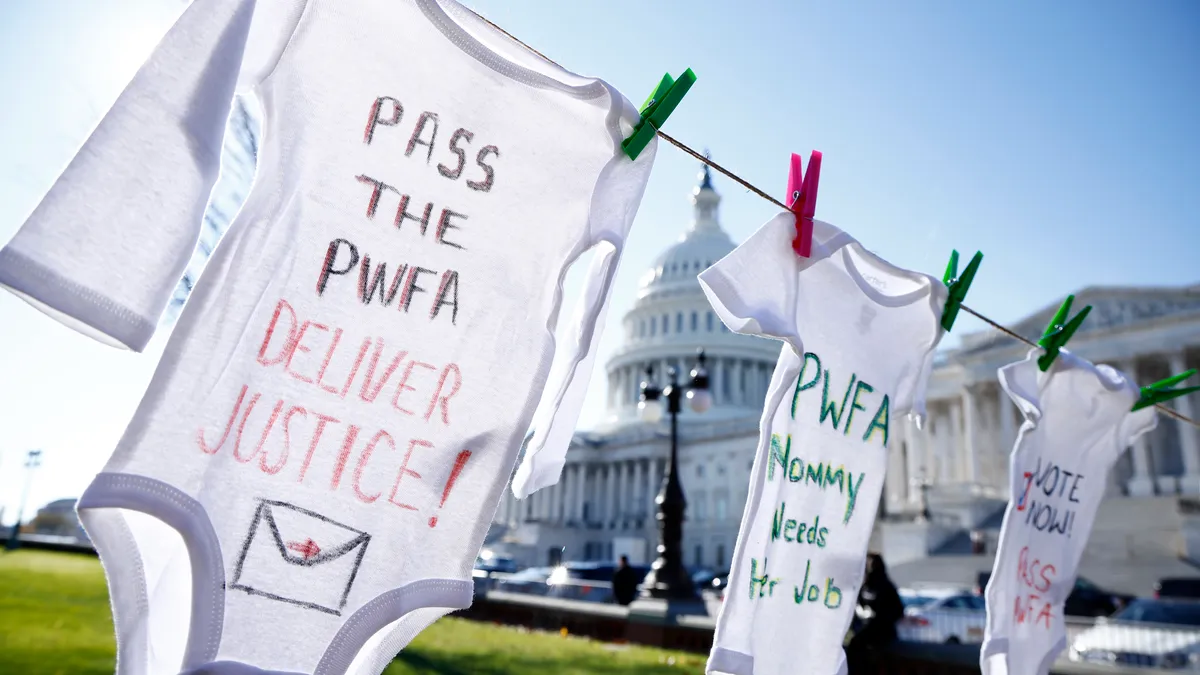Congress passed the Pregnant Workers Fairness Act in 2022 to codify protections for expectant employees not guaranteed under previous disability discrimination laws, namely the Americans with Disabilities Act and the Pregnancy Discrimination Act.
In doing so, lawmakers brought federal pregnancy protections closer to what had already existed in many states, but the legislation also creates new compliance considerations for employers, speakers at a Disability Management Employer Coalition virtual event said Wednesday.
“I’ve been singing its praises for a while now,” Marjory Robertson, assistant VP and senior counsel at insurer Sun Life, said of the PWFA, “but I think people are now starting to understand that it is potentially really going to disrupt things.”
How the PWFA intersects with the ADA
Robertson and Marti Cardi, senior compliance consultant at Matrix Absence Management, analyzed the PWFA’s provisions in two areas: accommodations and leave. On the former, the PWFA helps to close some of the gaps that existed for pregnant workers between the ADA and PDA.
Pregnancy is not a disability under the ADA, but the law does require employers to make reasonable accommodations for employees who have a physical or mental impairment that substantially limits a major life activity — including such conditions that are caused by pregnancy or childbirth.
Similarly, the PDA does not explicitly require employers to grant accommodations for pregnant workers. It does, however, require employers to treat pregnant employees the same as other employees insofar as their ability or inability to work. If employers provide modified tasks, alternative assignments, leave or other benefits to other, similar employees, they must also extend these provisions to pregnant employees.

The PWFA changed this equation by establishing a right to reasonable accommodation for eligible employees — those at employers with 15 or more employees — who have “known limitations” affecting their ability to perform essential job functions due to pregnancy, childbirth or related medical conditions. Such limitations need not be disabling, Robertson said, and the employee is entitled to an accommodation so long as it is temporary and does not cause undue hardship.
An employer’s PWFA compliance strategy may differ from its ADA-related policies. For example, the law explicitly prohibits employers from requiring an employee to take paid or unpaid leave if another reasonable accommodation can be provided.
“A number of employers under the ADA take the approach of, ‘We can’t give you what you want but you can have an unpaid leave.’ This law says you cannot do that,” Robertson said.
Even before the PWFA, regulators including the U.S. Equal Employment Opportunity Commission would be “all over employers” that forced pregnant employees out on leave without trying to allow them to work because of their pregnancy, Cardi said; “This just brings that lesson home, and employers should really take heed.”
The EEOC has provided an updated workplace anti-discrimination poster that includes information about the law.
EEOC regulations due before end of the year
The commission also released its draft PWFA regulations last month, and the final version of the document is due within a year of the law’s enactment, Robertson said.
EEOC proposed a broad interpretation of which “related conditions” are covered under the PWFA, Cardi said, which can include preexisting conditions that are aggravated by pregnancy or childbirth; “You have to think broadly when you assess whether one of your pregnant or recently [pregnant] employees is covered.”
For example, the nonexhaustive list of proposed related conditions includes termination of pregnancy — such as abortion — as well as infertility, mental illness and use of birth control, among others.
The commission also provided a list of four “simple modifications” that would not impose undue hardship in “virtually all cases” when requested by an employee due to pregnancy:
- Allowing an employee to carry water and drink, as needed, in the employee’s work area.
- Allowing an employee additional restroom breaks.
- Allowing an employee whose work requires standing to sit and whose work requires sitting to stand.
- Allowing an employee breaks, as needed, to eat and drink.
These accommodations will usually be reasonable accommodations and will almost never be an undue hardship, “so that’s an uphill battle to fight” for employers, Cardi said. Requests for these accommodations should almost never require medical documentation from the employee’s provider, she added.
The agency’s unexpected turn
Robertson highlighted the EEOC’s definition of “in the near future,” which specifically refers to the PWFA’s requirement that qualified employees — those who meet the criteria for PWFA coverage — be able to perform essential job functions with or without a reasonable accommodation.
If an employee cannot perform one or more essential functions, the individual may still be qualified under the PWFA if the inability to do so is temporary, the employee could perform the essential function(s) in the near future, and the inability to do so can be reasonably accommodated.
Upon reading the law, Robertson said that her initial belief was that “in the near future” would at least include the term of a pregnancy as well as the time needed to recover from childbirth. But the EEOC “took a turn” with its draft regulations, she said, by defining “in the near future” to mean a period of up to 40 weeks per accommodation needed.

According to Robertson, the 40-week period could essentially reset not only over the course of an employee’s pregnancy, but also after childbirth for accommodations granted to assist employees who have conditions such as postpartum depression.
But this would not necessarily constitute “a set allotment” of 40 weeks, Robertson said: “If you can show undue hardship, you don't have to allow it for this amount of time, though [EEOC does] say that you need to allow it for whatever amount of time until the undue hardship kicks in.” Robertson added that she would be surprised if this area of the regulations isn’t revised for the final version.
The regulations also note that leave offered as an accommodation under the PWFA is job-protected, and employers must continue offering health insurance benefits during such leave, Robertson said.
PUMP Act not the only word on lactation accommodations
Contained within the same piece of legislation that enacted the PWFA was the Providing Urgent Maternal Protections for Nursing Mothers Act, also known as the PUMP Act. The law requires employers to provide break time for workers to express breast milk as well as a space within the workplace to do so, with some exceptions.
The Fair Labor Standards Act has long required employers to provide nonexempt employees time off for lactation breaks in the workplace, but the PUMP Act expands this coverage to exempt employees as well, Cardi said.
Aside from the law’s exemptions for workers of small businesses and those in certain industries and job types, employers also should take note of state and local laws that cover lactation in the workplace, Robertson said. Moreover, the EEOC’s draft PWFA regulations note that lactation, including breastfeeding and pumping, is also included under the law’s definition of related medical conditions.
“It is becoming a more and more complicated area,” Robertson said of lactation protections in the workplace.





















